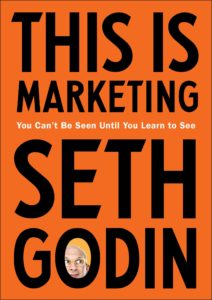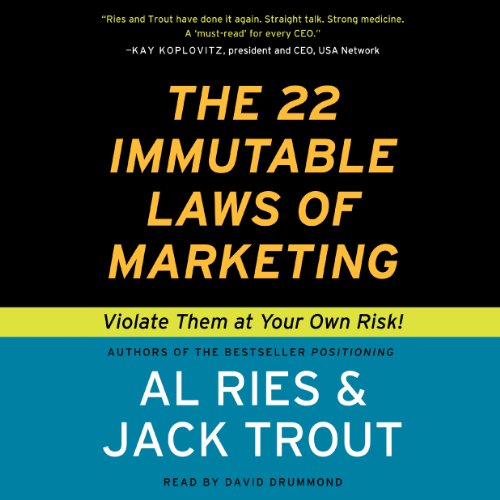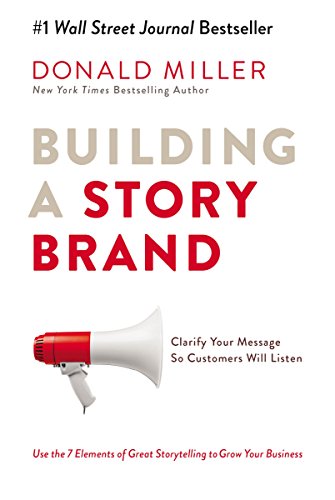There are many bestselling books that can help you with your marketing, how can you know which ones should be top priority for you?
And is This is marketing by Seth Godin one of them?


Intro (00:09:07)
Chapter 1: Not mass, not spam, not shameful. (00:15:00)
Chapter 2: The marketer learns to see. (00:07:46)
Chapter 3: Marketing changes people through stories, connections and experience (00:16:28)
Chapter 4: The smallest viable market (00:28:43)
Chapter 5: In search of better (00:38:07)
Chapter 6: Beyond Commodities (00:20:50)
Chapter 7: The Canvas of dreams and desires (00:18:23)
Chapter 8: More of the who, seeking the smallest viable market (00:20:17)
Chapter 9: People like us do things like this (00:21:55)
Chapter 10: Trust and tension create forward motion (00:15:30)
Chapter 11: Status, dominance and affiliation (00:27:57)
Chapter 12: A better business plan (00:05:56)
Chapter 13: Semiotics symbols and vernacular (00:18:59)
Chapter 14: Treat different people differently (00:12:17)
Chapter 15: Reaching the right people (00:24:16)
Chapter 16: Price is a story (00:16:23)
Chapter 17: Permission and remarkability in a virtuous cycle. (00:17:53)
Chapter 18: trust is as scarce as attention (00:06:30)
Chapter 19: The funnel. (00:43:26)
Chapter 20: Organizing and building a tribe (00:14:09)
Chapter 21: Some case studies using the Method (00:08:47)
Chapter 22: Marketing works and now it’s your turn (00:02:05)
Chapter 23: Marketing to the most important person (00:11:23)
Book Attributes
Author
Seth Godin is the author of a pile of bestselling books on marketing, currently more than 20, some of which include: Tribes, Linchpin, and Permission marketing. He also started two companies, one of which (Yoyodyne)
was acquired by Yahoo for 30 million dollars. One of his current main focuses is on his marketing workshops (Alt MBA and Akimbo).
Length
Audiobook: 7h 2m
Paperback: 288 pages
How I Decided to Listen to This is Marketing by Seth Godin
Once more I found one of the 6 influence principles from Robert B. Cialdini’s Book – Influence – “Social Proof” to be the driving force behind my decision. This book stands out because I have seen it reviewed by influencers, and it is bestselling on amazon, and also because I have heard the author’s name many times.
On top of that it fits the subject on which I am currently concentrating – Marketing.
Introduction
What is Marketing According to Seth?
Marketing is all around us and it influences every aspect of our lives.
As Seth sees it, marketing is our way to improve the lives of those we seek to serve, by raising their awareness to the change we seek to make, and helping them embrace it.
It should be our medium to grow deep connections in the form of great service and presentation, Instead of just making the surface shine and having a not-so-good service.
The essence of each of the 23 Chapters
For those of you who wish to dive deeper.
The Bold lines in the outset of the chapter can represent the main Idea of the chapter or the Idea that resonated with me most, because I couldn’t understand the main idea.
Also, a lot of the ideas that repeat themselves in different chapters were filtered. ( Just for you to know there are a lot of those in the book, don’t say I didn’t warn you 🙂 )
Chapter 1: Not Mass, Not Spam, Not Shameful.
In the TV age, marketing was simple, the louder you shout the more you sell. Now, however, it has changed 180° , now it is based on empathy and service.
In other words, put yourself in the audience’s shoes, and concentrate on delivering a worthy service first, and spreading the word later. NOT the other way around.
Chapter 2: The Marketer Learns to See.
Some Things Seth Learned in his early career (Presented as general Ideas which are elaborated throughout the book):
- Concentrate on a specific group of people, and make the product with them in mind.
- Create your product in alignment with their world view of status roles, so that they would receive a status boost when they interact.
Chapter 3: Marketing changes people through stories, connections and experience
Know your audience’s story to the detail and offer the change they crave.
- Share the story that will complete your customer’s narrative missing part, not your own.
- Our story is transmitted in every aspect of the business ( customer service, product quality, speed of shipment), remember to have a story that resonates with the customers and apply it.
"People don't want to buy a quarter-inch drill bit they want a quarter-inch hole"
Chapter 4: Smallest viable market
Look for a small group that is very interested in what you do but is big enough for you to make a living, rather than a big one that is a bit interested in what you do.
- Determine the psychographics* of your target audience. Then, drawing from that – Make a strategy and a promise on how you’re going to make a change for them.
- When you start serving the masses, there will be lots of objection, don’t let it drive you off your strategy, it’s not for them, it’s for the audience you initially took out to serve.
- Be able to clearly say who the product is for and who it isn’t for.
Chapter 5: In Search of Better
Don´t look for the absolute “best”, it doesn’t exist. Instead, look for the “best” for your specific audience.
- Understand that people’s attention is scarce, and only if you give them something that is truly valuable for them, will you be able to earn their attention. Like a lifeguard saving a drowning person, you should present help they desperately need.
- Don´t get stuck on existing solutions, look to improve society. Just like the supermarkets replaced the milkman.
Chapter 6: Beyond Commodities
If you don’t want people to decide whether to make business with you according to price, you need to stand out.
- Quality can’t be your only differentiator, there are lots of people who do quality work.
Just work is not enough! Create a vision that differentiates you! - Give people the emotions they want or else they might avoid both your product and your competitors.
- Standing for something requires courage and responsibility, that’s why people don’t do it.
- You have to present what the customer wants and expects it´s called being professional or doing emotional labor, and often requires not being authentic I.E. Smile and show empathy even when you’re in a bad mood.
- Take complete responsibility for each mail or contact as if you signed it, and thus create trust.
Chapter 7: The Canvas of Dreams and Desires
Concentrate on feelings rather than specs, sell dreams and wishes, not commodities.
The Feeling Brain drives our Consciousness Car because, ultimately, we are moved to action only by emotion. That’s because action is emotion.
- Your job is to innovate, and not expect the society to accept it overnight.
- Always keep testing and failing, to keep your spirit while failing, you may sometimes replicate parts of your content that you know your audience likes.
- Don’t expect to get paid 10x more just because you work more or produce more quantity. Instead, concentrate on marketing, know what’s special about the product you deliver.
- Become emotionally irresistible, it’s irrational, but works.
However, when it comes to actual purchasing, this is done with emotions and justified with logic after the fact.
Chapter 8: More of the Who, Seeking the smallest viable market
If in your smallest viable market there are a 1000 super fans who will buy each of your products, you can make a living.
- If your product is more fun or more useful the more people use it, it has a solid ground for spreading. Think of the benefits that your neophiliac* audience will get by offering your product to others.
- Every product has critics and admirers, look for specific criticism you could improve upon, not emotional and general criticism that will just hurt you, and have no use.
- When you and your customers disagree, you’re both right, it just means it’s not the right customer for you.
Chapter 9: People Like Us do Things Like This
One of the massive influence points on us is the fact that “people like us do things like this” for example, that’s why I chose to listen to this book.
- Making a change is extremely difficult because it has to align with people’s inner narrative. One of your best chances is – “people like us do things like this”.
- “Us” used to be “All of us”. Now, it should be defined very tightly for a small group of people, in order for them to know for sure you’re speaking about them, and change/normalize their behavior.
- To mimic the old phase is easy, but start a new, slightly different one, takes a leap, that’s where “people like us do things like this” might help you.
- Don’t look for a one – time hit, invest in your tree’s routes, just like Law 21: Acceleration in The 22 immutable laws.
Chapter 10: Trust and Tention create forward motion
Give a reason both to the early adopters to spread the word, and a reason for the rest of the people to change their behavior.
- You can create either a pattern match* or pattern interrupt*, to spread you’ll probably need to do both.
- Marketers create tension and forward motion I.E. Social Pressure. (not to confuse with fear) that causes change, the opposite from a cab driver, who operates in a set-up system.
- To change status quo, you must change a culture, and to change a culture you must include social status in the change
Chapter 11: Status, Dominance and Affiliation
If people get status out of engaging with your product or talking about it, you’re way ahead.
- Status is the driver behind seemingly irrational choices.
- When bringing work to market consider it’s status impact first.
- There are 3 factors by which people could be categorized into a status group: 1. Their view of themselves.
2. How others view them.
3. How they categorize the status of others (Affiliation* or Domination*). - You must prove you provide Affiliation or Domination in accordance with what your audience wishes. (Not you)
Chapter 12: A better business plan
There are better ways than a standard business plan to measure your success, according to Seth, here are the 5 metrics that do the work. Truth, assertions, alternatives, people, money.
Truth – How things objectively are: How much competition is there? How many customers are there in this area?
Assertions – How well do you keep your promise to the market?
Alternatives – What will you do if you fail to deliver on the promise.
People – Who are your clients and employees?
Money – How much did you earn or lose? Taxes, break-even point*, all expenses and incomes, etc.
– As soon as you stop asking how to get traffic and ask what change you wish to make everything will be a lot more clear.
What’s the change that you want to make? Would be glad to hear your thoughts in the comments in the bottom of the post!
Chapter 13: Semiotics, Symbols and Vernacular
Our symbols, colors, images and decoration remind the prospects of some pleasant or unpleasant thing, that’s why we should pay attention when we pick them.
- Make trustworthy signals but with a special twitch to let the prospects know it’s yours. Despite your attempts, sometimes your symbols resemble some bad experience, find people who are okay with it (neophiliacs).
- You only have fans because they expect something from you next time when they look at your symbols, if they don’t – you’re a commodity.
- To have a brand – build connections and other unique/non-transferable qualities.
- Your logo matters but it’s is not a matter of life or death, you better have one to create a mental image of your brand, and stick to it “as long as you keep your first name”.
Chapter 14: Different People Want Different Things
But even within your chosen target audience, there are different people who need different treatment…
- There is the neophiliac, the middle of the curve* and laggard*. You should start with earning enrollment by neophiliacs, the people who want the change.
- What your audience wants depends on the audience you serve, workaholics or convenience seekers, Dominion or Affiliate minded. Know who you serve.
- Today every customer can assume a power role, if you spot someone with that potential give him the right tools to do it.
- Mostly, certain customers contribute most of the business profit, pay attention to that in the customer base, and give them special treatment.
Chapter 15: Reaching the Right People
What kinds of advertisements are there? Tips for using the media to reach your market.
Goal, Strategy and Tactics
Advertising Tactics and Tips
- If Ads work they’re easy to scale, but it’s hard to find the ones that work.
So keep testing and don’t give up until you succeed - Remember: We only remember the things we go over frequently, and for long enough, so don’t change your ads all the time!
- How to do Direct Marketing*: Assign values to each step of the funnel, if you can’t – don’t do direct marketing.
- How to do Brand Marketing*: Think how you want your brand to look and integrate it in every interaction between your business and audience.
- SEO*: Not everyone can rank number one on SERP*, instead, you should have them look for something specific and be the one they want to find.
Chapter 16: Price is A Story
Make a story that will allow you to put a high price on your services.
The effect of price on your audience
- A high price supports our Story and gives us a margin to spend on better marketing.
- A low price is usually a sign of a commodity.
- When people pay a high price they back their choice up with a story to support it, and give you trust.
- Free is the ultimate price and is very attractive, but you can’t survive off of it.
Tips for establishing your pricing
- A good solution is to combine both free value and paid products.
- You could only charge a high price if your story aligns with it.
- Generosity in the form of discounted work can’t be sustained in the long term, instead give them a good respectful service for the right price and it will build mutual respect.
Note
Chapter 17: Permission and remarkability in a virtuous cycle
Permission Asset
A most effective way to communicate to a customer is through a Permission Asset* .
Additional Information About Permission Assets:
-It’s low cost
-A Social Media page is not your asset, it’s the asset of the Social Media company.
Tips for Permission Marketing
-Start with a promise, and reinforce it with frequency. Your marketing comes after the promise is made.
-Make it Personal, Consistent and Relevant.
-An effective way to build a permission asset, is to access your audience through another permission asset.
Permission is like dating, you don't start by asking for the sale at first impression, you earn the right overtime, bit by bit.
Remarkability
Make your product remarkable when you design it and the word will spread
What is Remarkable?
A product/service is only remarkable when the consumer remarks on it and it makes them feel generous to remark, not when you think it is.
On the contrary, if a negative word spreads it is to warn people from you.
Chapter 18: Trust is as scarce as attention
Actions create trust, NOT talking.
Trust is not obvious and is very important
- There’s distrust in the internet as the result of rip-offs.
As a marketer you can be either Ignored or Sneaking around or Trusted.
Being trusted is the only way for long term relationships.
the more trust you earn the more likely the readers are to follow you.
How to establish trust
- If you’re famous, and people who are well connected trust you, they will bring you the audience that trusts them.
- Establish public relations – Be famous to the right people, NOT publicity – famous to everyone.
Chapter 19: The Funnel
Measure your Funnel* and improve it until it is profitable.
Things you should know about The Funnel
- With every step of the funnel you lose people.
- The dream funnel is one that returns more than you pay.
- Customer lifetime value* is probably the most important metric you have to calculate in a funnel.
Tips for Managing The Funnel
- Measure the ad’s ROI* and fix the funnel before you buy more ads if it’s not profitable.
- Eliminate excessive steps between the beginning and the ending of the funnel, because you lose people at every step. Don’t overdo it though, because it will reduce trust.
The Last Step of The Funnel
- Remember: Ads bring you the customers, but the quality of the product spreads the word, and this is where the money is made.
Other Marketing Tips
- Every market has a Short Head* and a Long Tail*.
By being a part of the long tail of a category that still has no short head, you raise your chance to be in the short head significantly. - Many organizations crash at The Chasm* / Trough*. To avoid it, create a product that is more useful the more it’s shared and also keep consistently marketing.
- There is the Global Chasm* and Local Chasm*. You don’t have to pass the global chasm, you could pass the local one. What you’ll need for that is neophiliacs and a Network effect*.a
Chapter 20: Organizing and building a tribe
Connect your tribe using stories and common goals. Also, commit to them in the long term!
The Story of the SUN
Tell the story of the SUN:
Self – Your own transformation
Us – Why is that related to the audience
Now – Provide the tension that is needed for the audience to begin the journey.
Invest in your people
- Don’t look to compete with/eliminate your opponent, look to treat the people you serve and your employees in the best way possible.
- Your community shares goals and interests, your mission is to connect them, you can do it by events like the Nike 4-minute mile challenge, cultural artifacts like shirts of your brand, etc.
Commit for the long term
- If you don’t keep investing in your tribe they will become less and less interested. Hunker down with your tribe, commit for the long term, don’t be chasing the next shiny object.
Personal Note: Until you can systematize your business that is.
Chapter 21: Some Case Studies Using The Method
Examples that represent some of the book´s principles
- The “Tesla” used the story of a certain group of people who were attracted to “the best” car, it was concentrated and applied to a little audience.
- The NRA (National Rifle Association) has gathered 5 million members, which is relatively small and they are criticized by many, but this small audience gives them A LOT of edge to influence politics .
- Marketing to an individual (I.E your boss) could also be executed through enrollment, just as you’d do with a group. Turn her to a student, and teach her bit by bit, by committing and showing up with frequency.
Chapter 22: Marketing works and now it is your turn
Don´t look for perfection, shoot for good enough and be generous enough to ask and offer help.( Hope this post is not too perfect, doesn’t seem so to me 😉 )
- Don’t look for perfection, because then you forbid yourself to improve.
- Instead look to make work that is Good Enough and constantly Improve it.
Good enough leads to engagement and enrollment. - Refusing to offer help or ask for it puts people on defence.
While offering or asking for it increases trust. No trust no business.
Chapter 23: Marketing to The Most Important Person
You must always be able to sell the service you do to yourself, if you can´t – improve/change it!
- Trying to make change feels risky and requires responsibility.
If the market doesn’t accept you, don’t take it personally or think you’re a bad person, it only means that either you have to improve at your craft or your marketing. - People only buy from you if what you’re selling is worth more than their money.
If you don’t find a way to market that, you’re stealing.
Look, it’s possible your marketing sucked. Try it all over again, and when you served one person and they could use your change, keep going because society needs you. - Marketing is a tool, and if it indeed works and you master it, use it for good.
With great power, comes great responsibility.
My general experience of the book
Despite listening to the book 4-5 times, still struggling to catch a narrative
I believe I have listened to this book 4-5 times by now, and then re-read my own summary. It has some pretty important understandings about marketing, but the problem is that I feel that Seth had just thrown all his thoughts on paper and added headings and subheadings to it afterwards, therefor there is no chronological order, also many times it is unclear whether he is giving examples or trying to convey an Idea, therefor after reading it for the first couple of times I felt that I did not know what to make of the book and couldn’t really remember what it said.
I bet he knows what he's talking about...
Essentially Seth seems to know what he is talking about because he has great popularity with almost every new book that he writes, which ends up becoming an instant bestseller.
2 things I struggle to accept
1. Minimum Viable Product
There are 2 other things I struggle with accepting, the first one is that he says we should just go for the minimum viable product, so that there would be frequency. And that is what he seems to be doing with his books, maybe that’s why it seems so unorganized…
Though I agree of course that frequency is important and differentiating between to much effort and too little is critical.
2. Any audience reacts badly when at discount detox
And the other is that there’s one Idea that contradicts Law 11 of the 22 Immutable Laws the law of perspective. He says that the customers of J.C. Penny stopped visiting the store because the CEO stopped the Constant sales, and they were the kind of audience who liked sales, but the CEO’s move was right, it’s just that when audience gets used to constant sales, it’s difficult to bring them back to the normal prices, no matter what kind of audience it is (According to Law 11). So what Seth saw in J.C. Penny was actually withdrawal symptoms, which were supposed to correct themselves but eventually probably didn’t have enough time, so they went bankrupt.
The Ideas have merit but it is unorganized
To repeat, seperately many of the Ideas have merit, but it takes lots of concentration and repetition to extract the essence of those, to understand it and remember it. Nontheless you may enjoy it if you are just looking for a read-through and catching Ideas on the go.
Also many of the Ideas are repeated over and over again in different chapters which also makes it difficult to relate each heading to a different subject, it’s not clear which principle is the main one discussed in the chapter.
2 Takeaways
1. Standing for Anything is Better than nothing.
1. Better stand for something than nothing, and even better stand for something that your competition doesn’t stand for. Only this way you could turn from a me2 business to a creator of change. I.E. If all the teachers say that they are patient and thorough, you could say I’m strict and get my students to be competitive.
(Equivalent to Law 14: Attributes from The 22 Laws of Marketing)
2. A quarter inch hole
Remember that I’m not selling book reviews, I’m selling what the book reviews could get you guys, which is picking the books that will help you develop your business and avoid all the time wasted on indecision.
By the way, a great timesaver is Audiobooks! Check out the post about audible to decide if it’s for you! They also offer their first book for free!
Rating
Narration
Quality – 5/5 Sound quality is high, no sighs, gulps, jumps in volume etc.
Clarity of Speech – 5/5 no mumbling or mispronouncing, words are clearly stated
Engaging – 3/5 In many cases he speaks in a numb manner, and it made me feel like falling asleep a bit.
Expression of Feelings – 3/5 Same here, the feelings are expressed well in some cases, while in others it feels like he’s bored or is reading a bedtime story
Final Narration – 16/20
Examples
Storyline/Plot
– This book was not written with plot in mind, rather like a collection of Ideas
Rating – N/a
Headline division
In many cases the headlines are not indicating the content well, so that even after listening to the book around 4-5 times when I return to them I still don’t have a clear vision of what the chapter was trying to convey.
Moreover, the audible audiobook doesn’t even have the chapter names in it, rather just numbers of the chapters
Rating – 6/20
Content
There are a lot of marketing Ideas that are correct and to the point. But they’re conveyed in a bit of a mess, and so they’re a bit unclear
Also many of the Ideas are repeated over and over again throughout the different chapters while having no additional value, and making you even more confused as to the main Idea of the chapter.
Rating – 13/20
Drive to Implicate
The last two chapters are dedicated to motivate us, and call us to action, though the feeling throughout the book is that it’s just lots of theory (Maybe because of the narration).
Rating – 12/20
Final Book Rating - 57/100
Conclusion
In conclusion, though the rating turned out to be pretty low, This is Marketing has many Ideas that are good marketing practices.
I wouldn’t say it is a complete waste of time, but sorry Seth, it is not written/Narrated in the best way in my opinion.
Get 5 Marketing Mistakes to Avoid from 5 Known Marketing Books
YouTube Summary
Acquiring Options
(In case you still want to checkout this multi-time bestselling author.)
Get awesome Bonus PDF with 8 Audible Moneysaving Tricks and Tips.

Decided to get “This is Marketing” through the Amazon links above or with audible trial? Awesome! Let’s save you a bunch of money with this PDF! Just fill in the form or alternatively send me a mail to yan@improvementor.blog with your Order Number and I’ll send you the PDF as soon as possible (Usually within 24 hours)
Related Articles

The Great 22 Immutable Laws of Marketing Book Review
What things may be failing your business? How to get into a competitive category, and become it’s leader? Those are a few of the questions

Building a StoryBrand – Create your 7 Step Narrative for Business Growth
Continuing the journey to positioning, and online income. This time reviewing ” Building A StoryBrand ” the goal of which is to help overcome overcluttering

(89/100) Start a Business the Right Way – The E-myth revisited Marketing Book Summary/Review
Good day to everyone who’s here to take on the world with their business ventures!The E-Myth revisited by Michael E. Gerber is rated as the


